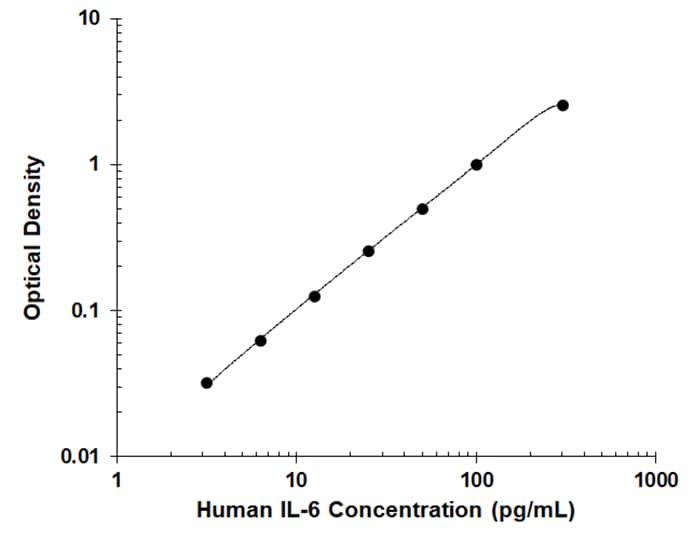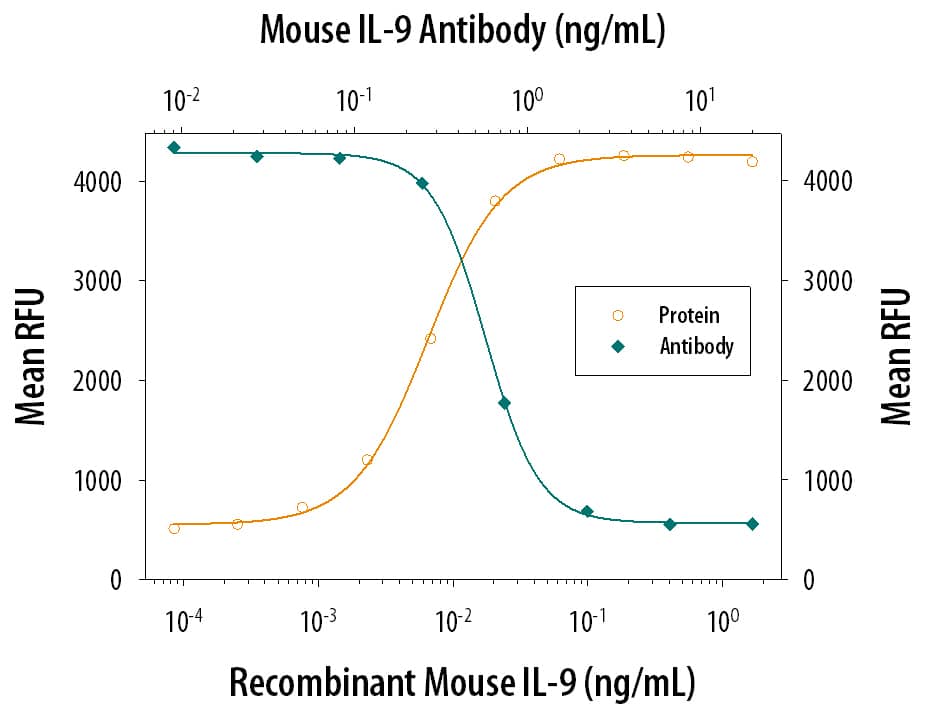Human SP-D Antibody Summary
Ala21-Phe375 (Glu22Gly)
Accession # P35247.2
Customers also Viewed
Applications
This antibody functions as an ELISA detection antibody when paired with Mouse Anti-Human SP‑D Monoclonal Antibody (Catalog # MAB19201).
This product is intended for assay development on various assay platforms requiring antibody pairs. We recommend the Human SP-D DuoSet ELISA Kit (Catalog # DY1920) for convenient development of a sandwich ELISA or the Human SP-D Quantikine ELISA Kit (Catalog # DSFPD0) for a complete optimized ELISA.
Please Note: Optimal dilutions should be determined by each laboratory for each application. General Protocols are available in the Technical Information section on our website.
Scientific Data
 View Larger
View Larger
Human SP‑D ELISA Standard Curve. Recombinant Human SP-D protein was serially diluted 2-fold and captured by Mouse Anti-Human SP-D Monoclonal Antibody (Catalog # MAB19201) coated on a Clear Polystyrene Microplate (Catalog # DY990). Mouse Anti-Human SP-D Monoclonal Antibody (Catalog # MAB1920) was biotinylated and incubated with the protein captured on the plate. Detection of the standard curve was achieved by incubating Streptavidin-HRP (Catalog # DY998) followed by Substrate Solution (Catalog # DY999) and stopping the enzymatic reaction with Stop Solution (Catalog # DY994).
Preparation and Storage
- 12 months from date of receipt, -20 to -70 °C as supplied.
- 1 month, 2 to 8 °C under sterile conditions after reconstitution.
- 6 months, -20 to -70 °C under sterile conditions after reconstitution.
Background: SP-D
SP-D (surfactant protein-D; also PSP-D) is a 43 kDa member of the collectin family of innate immune modulators. It is constitutively secreted by alveolar lining cells and epithelium associated with tubular structures. Its principal components consist of a collagen-like region and a C-terminal carbohydrate recognition domain (CRD), a structure that further places it in a subset of an expanded group of proteins termed defense collagens (1-4). Human SP-D is synthesized as a 375 amino acid (aa) precursor. It contains a 20 aa signal sequence and a 355 aa mature region. The mature molecule is characterized by the presence of a 25 aa N-terminal linking-region, a 177 aa hydroxyproline and hydroxylysine collagen-like domain, a 46 aa coiled-coil segment, and a 106 aa, C-terminal collectin-like C-type lectin domain (CRD) (5, 6). Two additional, potential isoforms exist. One shows a 13 aa N-terminal extension, while the other combines the N-terminal extension with a deletion of aa’s 206-375. Mature human SP-D shares 75% and 78% aa identity with mouse and pig SP-D, respectively. Monomeric SP-D is unusual (3). The basic form of SP-D is that of a glycosylated, disulfide-linked 150 kDa trimer that generates an alpha -helical coiled-coil structure linked to a “head” of three symmetrical CRDs (4, 7). Each CRD recognizes the hydroxides of one monosaccharide (4). Trimerization allows for the discrimination of monosaccharide patterns specific to microbial pathogens (7). Typically, SP-D forms a higher-order 620 kDa, X-shaped dodecamer through disulfide bonds associated with the N-terminus (8). This allows for even finer discrimination of self vs. nonself carbohydrate patterns, and facilitates binding to complex antigens (8, 9). One polymorphism, a Met11-Thr11 transition in human, apparently precludes the formation of oligomers, potentially affecting the ability of affected individuals to interact with microorganisms (9, 10). Finally, SP-D is known to bind both SIRP alpha and the calreticulin/CD91 complex on macrophages. When the ratio of antigen/pathogen to available CRDs is low, antigen can be bound without occupying all available CRDs. The free CRDs will bind to SIRP alpha, generating a signal that downmodulates the inflammatory response. When virtually all CRDs are occupied by ligand, however, free CRDs are not available for SIRP alpha binding. Instead, the dodecamer is depicted to undergo a structural rearrangement, exposing the N-termini of all four linked trimers. This exposed terminus is known to bind to the calreticulin/CD91 complex, an event that initiates inflammation. Thus, it would appear that SP-D allows for a graded response to environmental challenge. SP-D provides a mechanism for the clearance of small antigenic insults without the need for a damaging inflammatory response (3).
- Holmskov, U. et. al. (2003) Annu. Rev. Immunol. 21:547.
- Kishore, U. et. al. (2006) Mol. Immunol. 43:1293.
- Hartl, D. and M. Griese (2006) Eur. J. Clin. Invest. 36:423.
- Sim, R.B. et. al. (2006) Novartis Found Symp. 279:170.
- Rust, K. et. al. (1991) Arch. Biochem. Biophys. 290:116.
- Lu, J. et. al. (1992) Biochem. J. 284:795.
- Hakansson, K. et. al. (1999) Structure 7:225.
- Ohya, M. et. al. (2006) Biochemistry 45:8657.
- Crouch, E.C. et. al. (2006) Am. J. Respir. Cell Mol. Biol. 35:84.
- Leth-Larsen, R. et. al. (2005) J. Immunol. 174:1532.
Product Datasheets
Citations for Human SP-D Antibody
R&D Systems personnel manually curate a database that contains references using R&D Systems products. The data collected includes not only links to publications in PubMed, but also provides information about sample types, species, and experimental conditions.
5
Citations: Showing 1 - 5
Filter your results:
Filter by:
-
Development and Application of Human Coronavirus Protein Microarray for Specificity Analysis
Authors: Pin-Xian Du, Yi-Yu Chou, Harvey M. Santos, Batuhan Birol Keskin, Miao-Hsi Hsieh, Tzong-Shiann Ho et al.
Analytical Chemistry
-
Interplay between host humoral pattern recognition molecules controls undue immune responses against Aspergillus fumigatus
Authors: Dellière, S;Chauvin, C;Wong, SSW;Gressler, M;Possetti, V;Parente, R;Fontaine, T;Krüger, T;Kniemeyer, O;Bayry, J;Carvalho, A;Brakhage, AA;Inforzato, A;Latgé, JP;Aimanianda, V;
Nature communications
Species: Fungus - Aspergillus fumigatus
Sample Types: Conidia
Applications: Immunohistochemistry -
The Netrin-4/Laminin gamma 1/Neogenin-1 complex mediates migration in SK-N-SH neuroblastoma cells
Authors: Andrea A. Villanueva, Sofía Puvogel, Pablo Lois, Ernesto Muñoz-Palma, Manuel Ramírez Orellana, Fabiana Lubieniecki et al.
Cell Adhesion & Migration
Species: Human
Sample Types: Whole Tissue
Applications: Immunohistochemistry -
Fungal melanin stimulates surfactant protein D-mediated opsonization of and host immune response to <em>Aspergillus fumigatus</em> spores
Authors: S Sze Wah Wo, M Rani, E Dodagatta-, O Ibrahim-Gr, U Kishore, J Bayry, JP Latgé, A Sahu, T Madan, V Aimanianda
J. Biol. Chem., 2018-02-05;0(0):.
Species: Human
Sample Types: Whole Cells
Applications: Direct ELISA, Flow Cytometry, ICC -
The Netrin-4/Laminin gamma 1/Neogenin-1 complex mediates migration in SK-N-SH neuroblastoma cells
Authors: Andrea A. Villanueva, Sofía Puvogel, Pablo Lois, Ernesto Muñoz-Palma, Manuel Ramírez Orellana, Fabiana Lubieniecki et al.
Cell Adhesion & Migration
FAQs
No product specific FAQs exist for this product, however you may
View all Antibody FAQsIsotype Controls
Reconstitution Buffers
Secondary Antibodies
Reviews for Human SP-D Antibody
There are currently no reviews for this product. Be the first to review Human SP-D Antibody and earn rewards!
Have you used Human SP-D Antibody?
Submit a review and receive an Amazon gift card.
$25/€18/£15/$25CAN/¥75 Yuan/¥2500 Yen for a review with an image
$10/€7/£6/$10 CAD/¥70 Yuan/¥1110 Yen for a review without an image














